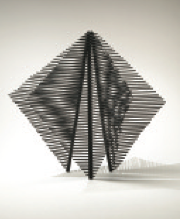Constructive Spirit
The Newark Museum. New York
The Newark Museum is a small gem that has unjustifiably been kept outside of the radar of the New York area museums spotlight. Fortunately for us, upon its one hundredth anniversary, this small museum is finally getting some attention with Constructive Spirit: Abstract Art in South and North America. This exhibition, organized by Mary Kate O’Hare, aims to rewrite the history of abstraction as we know it by exposing the connections and exchanges between the geometric abstract art movements of Argentina, Brazil, the United States, Uruguay and Venezuela. Comprised of over ninety paintings, sculptures, prints, photographs, drawings and films, Constructive Spirit teaches us that abstraction is more than a mere art movement; that it is, rather, a spirit that knows no geographical or historical boundaries. As viewers, we are not compelled to compare the works of artists from different hemispheres, or determine who did it first or who influenced whom. Instead, the narrative of the exhibition insightfully guides the viewer to explore the affinities shared by these artists without neglecting the particular contextual circumstances that prompted these tendencies in each artist’s work.

The narrative of Constructive Spirit unravels through a series of thematic sections. The first, “Urban Landscapes,” featuring Joaquín Torres García and Stuart Davies among others, seeks to define the urban metropolis as an inspiration for the rise of constructivist styles in the beginning of the twentieth century. Torres García’s New York Street Scene paired with Davis’ Egg Beater No. 2 is astute as they are works that are quite differ- ent, but at the same time in share an underlying geometric sen- sibility drawn from the modern urban landscape. The following section titled “New Realities” presents artistic movements with similar affinities such as the American Abstract Artists group founded in the United States, the Asociación Arte Concreto- Invención in Argentina, the Grupo Ruptura in Brazil and group Arte No Figurativo in Uruguay. This section not only revisits the Latin American abstraction exhibition Geometry of Hope shown at the Grey Art Gallery in New York in 2007, but also succeeds in expanding the geographic parameters of the style by juxtaposing works such as Burgoyne Diller’s Untitled (First Theme), and Tomás Maldonado’s Untitled from 1948.
Of all the sections, “Temporal Rhythms” is the most vibrant, comprising the works of artists who have explored unpredictable and ever-changing compositions. The highlight is the film by Carlos Cruz Diez, Movement and Vibration in Space: Sculpture by Gego, where the artist experiments with the framing and the movement of sculptures by fellow Venezuelan artist Gego, creating two dimensional kinetic compositions of unique poetry. The experience is further enhanced by the presence of the actual Gegofón of 1959, displayed prominently in the same gallery. Unfortunately, the most compelling grouping of works under the theme of “Universal Forms” is set-aside in a separate gallery. In this “capsule,” the work of artists who have drawn from American indigenous aesthetics from both hemispheres hangs side by side. Most noteworthy is the pairing of works such as Torres García’s Composition of 1932 and Louise Nevelson’s of 1957, where the affinity of their influences is perceived but is not obvious.
In fact, Constructive Spirit thrives due to its very lack of blatancy. The associations between works are not forced, and the thematic narratives in which the works are framed astutely guide the viewer to feel the spirit of the work. Therefore the daringness of showing geometric abstract works of artists from North and South America side by side suddenly becomes a lesson in understanding an aesthetic sensibility without geographical or historical boundaries.





